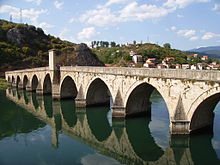The bridge over the Drina
The Bridge over the Drina ( Cyrillic Na Drini ćuprija , На Дрини ћуприја ) is a historical novel by Ivo Andrić . The title refers to the Mehmed Paša Sokolović Bridge in Višegrad .
Release history
The bridge over the Drina is one of Andrić's most important works and was decisive for him to be awarded the 1961 Nobel Prize for Literature . The book was created during the author's retired creative period in Belgrade during World War II and was published in 1945. In 1953 Ernst Jonas' first translation into German was published. With the novels Wesire und Konsuln (original title Travnička hronika , German first issue 1961) and Das Fräulein ( Gospođica , German 1958), both of which were also published in 1945, the bridge forms the author's “Bosnian trilogy”.
action
The novel covers four centuries of a chronicle of this region, first under Ottoman and later under Austro-Hungarian rule and tells of the coexistence of nations and religions in the area of Višegrad against the background of the bridge and the associated caravanserai and the river Drina . The plot begins at the time of the birth of the later Grand Vizier Sokollu Mehmed Pascha in Rudo 1506, tells of the construction of the bridge as a connection between the Ottoman heartland and the later Bosnia and Herzegovina . Andrić draws the world of the people on and on the bridge, in the middle of which Bosnians and Turks, Christians and Muslims, Orient and Occident meet. It tells of the crisis of the empire, the takeover of Bosnia by Austria-Hungary after the Berlin Congress , the rise of nationalism and the crises and wars up to the 20th century. The book ends with the bridge being blown up by the Austrian army, retreating from the Serbs , when the Drina became the front line in World War I.
Style and shape
Andrić chose the distant tone of a historian for his novel, which is seldom interrupted by dialogue. He largely renounced dramatizing linguistic means in favor of an objectifying, authorial narrative style, mixed with elements of the folk and regional language that he was familiar with from his youth in Višegrad. There are no characters throughout the novel, instead the author lets the episodes and characters come and go in a colorful dance, while the only element that completely spans the plot remains the eponymous bridge itself.
expenditure
Original editions
Na Drini ćuprija. Višegradska hronica. / На Дрини ћуприја. Вишеградска хроника.
- Belgrade 1945; 9th edition 1953.
- Belgrade / Sarajevo 1958 (in Izabrana dela , 4 volumes, 4).
- Belgrade 1963 (in Sabrana dela , 10 volumes, 1).
- Novi Sad / Belgrade 1965.
- Belgrade u. a. 1976 (in Sabrana dela , 16 volumes).
- Sarajevo 1985.
German-language editions
The bridge over the Drina. A Wischegrader chronicle. (Translation by Ernst E. Jonas)
- Zurich 1953.
- Munich 1959.
- Berlin 1961.
- Frankfurt am Main 1974.
- Munich 2013.
Web links
- Urs Bitterli , Ivo Andrić - The Bridge over the Drina (1945) , in: Journal 21 , April 7, 2013 (accessed January 20, 2015).
- Wolfgang Schneider: It divides and connects cultures , Deutschlandfunk , August 1, 2011 (accessed January 20, 2015).
- Andreas Breitenstein : Chronicle in Stein , Neue Zürcher Zeitung , May 24, 2011 (accessed January 20, 2015).
- Thomas Parschik: The Bridge of Visegrád In: Das Blättchen , 21st year, No. 4 from February 12th, 2018
